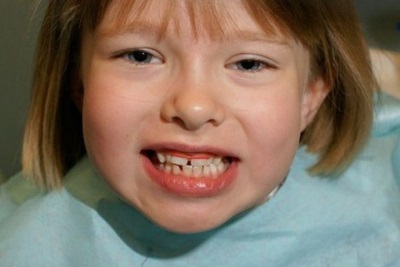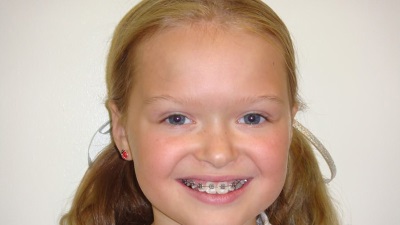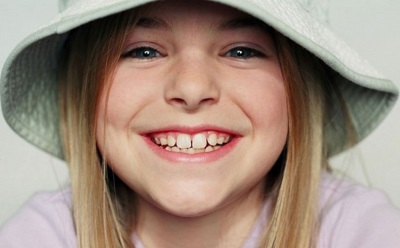Curved teeth in children
When milk teeth are cut at the crumbs, and then replaced by molars, parents first of all pay attention to their health and prevention of caries. And such a fairly common problem, like crooked teeth, is often overlooked. This can lead to the emergence of complexes in adolescence in a child, so even at the stage of teething baby teeth, it is important for parents to find out why their curvature is possible, what it threatens the child with, and whether it is worth worrying if the crumbs have a crooked pattern.
Why teeth are bent
Dairy
Dentists say that the curvature of milk teeth is quite rare. As a rule, if a baby's teeth are cut by curves, then after the appearance of the entire tooth row, they are gradually “rubbed in” and aligned.
Parents of preschool children are more concerned about the gaps between their milk teeth, but this should not be the cause of unrest. The sizes of milk teeth are small and immediately after eruption, in most cases, these teeth are located quite close to each other. But the child grows, and his jaw gradually increases, which leads to the separation of milk teeth with the appearance of uniform crevices.
This is absolutely normal and important for the subsequent change of teeth. The child should be shown to the doctor only when irregular gaps appear, which may occur due to asymmetric development of the jaws.
The curvature of milk teeth often leads to:
- Lack of vitamins and minerals in the nutrition of the future mother during the period when the fetus had the beginnings of teeth.
- Monotonous feeding of the baby, in which the crumb does not receive enough trace elements, vitamins and calcium.
- Too low load on the child's teeth when the baby is fed only ground and chopped dishes over the age of 8 months.
- Chronic diseases of the nasopharynx, because of which the child breathes through the mouth.
- Harmful habits in a child, for example, constant sucking a pacifier, sleeping with a pacifier, sucking a finger or feeding from a bottle over the age of one year.
- The influence of heredity.
Indigenous
Curvature of permanent teeth is a common problem associated with their uneven eruption, which occurs within 6-9 years. The fact is that molars appear of the size that they will have until the end of life, and the child’s jaw does not have enough time to grow enough to accommodate larger teeth by the time individual teeth appear. As a result, new teeth begin to grow crooked or even grow into 2 rows.
As long as a tooth is only being cut, its incorrect location may be temporary. Often, the front teeth first grow crooked, but gradually unfold. But in most cases, abnormally growing teeth remain curved, which requires treatment from an orthodontist. Another fairly frequent cause of the curve of the eruption of a permanent tooth is the wrong baby tooth in its place.
Consequences of curvature of milk teeth
If milk teeth are crookedly climbing, the child should certainly be shown to the doctor, as this is fraught with such risks:
- The child will also have crooked permanent teeth. If the dairy ones are not positioned correctly, the molars of the molars can also bend and grow at an altered angle.
- Incorrectly positioned teeth are harder to peel off, causing the teeth to become infected with caries.
- Gum tissue between crookedly growing teeth can also become infected with the development of periodontitis.
- A crooked tooth can permanently traumatize the oral mucosa, causing chronic stomatitis.
- The kid will chew on food badly, which will affect the work of the digestive tract.
- The child will be ashamed of his crooked teeth, not enough to smile and laugh, which will cause him psychological problems and interfere with communication with peers.
- Increases the likelihood of problems with the temporomandibular joint, which are manifested by tension and pain in the jaw, clicking in the joint and headaches.
The causes and consequences of improper bite of milk teeth can be found by watching the following video.
What to do
As soon as the parents notice that the child's teeth are twisted, you need to go with a crumb for a consultation to the dentist. The doctor will determine the cause and assess how serious the problem is with the teeth.
If the teeth are twisted due to bad habits, they will have to be fought, and if adenoids become the cause of the problem, an ENT consultation is needed.
Nowadays, there are many methods for correcting bite. The most common ones are to use:
- Braces The design is used in children who have crooked molars. Usually it is prescribed to children over the age of 12-14 years, so that the equipment does not prevent the growth of the jaws. The device is represented by metal arcs to which the guide teeth are attached. For several months or years, they affect the teeth and gradually change their position.
- LPs. They are often prescribed to children aged 7-12 years. Such devices are non-removable (they are used in the curvature of a large number of teeth), as well as removable (they are used to align single teeth). They are a plastic plate made individually for each patient, on which a strong metal arc is fixed and there is a fixing mechanism. The arc provides constant pressure on crooked teeth, as a result of which they align within 1-2 years.
- Trainers So called tires of elastic material, worn at night. At the initial stage of using such tires, more flexible soft trainers are used, and after about 6-8 months they begin to use the final trainer made of a harder material. Such a hard trainer is also worn for about 6-8 months.
In addition to the correction at the dentist, it is important to pay attention to such points:
- Daily thorough dental hygiene, which will protect the baby's teeth from infection by bacteria and subsequent destruction.
- Full nutrition crumbs, thanks to which the baby will receive all the necessary for the growth and strengthening of the tooth substance.
- The presence in the child's diet of solid foods that need to be chewed, for example, raw carrots, apples, crackers and similar food.
















